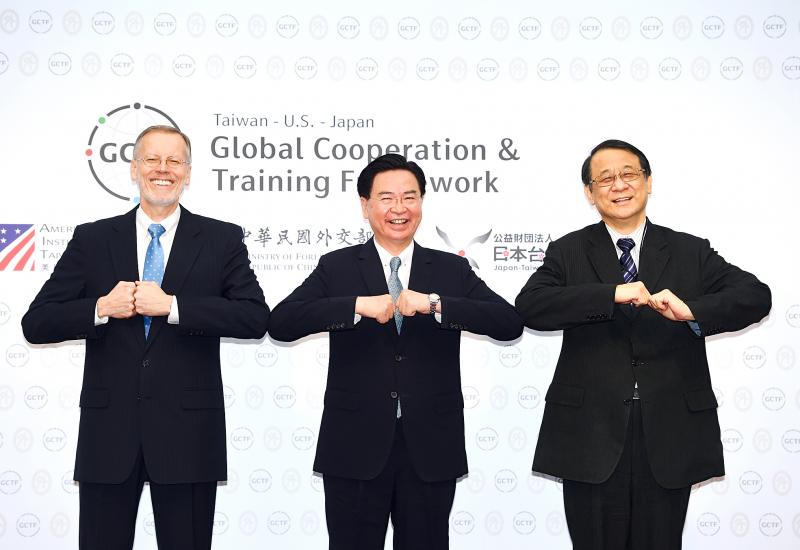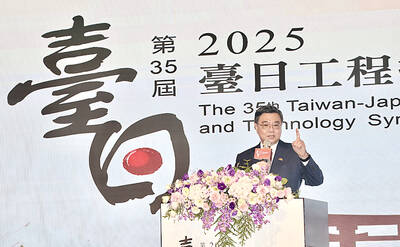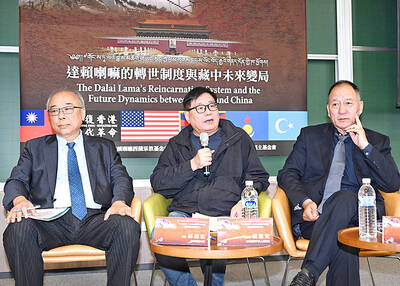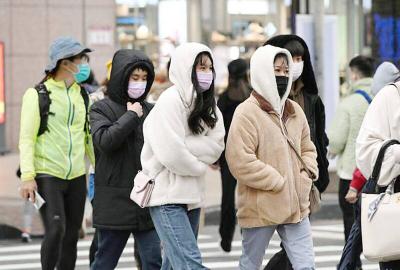Taiwan, the US and Japan yesterday issued a joint statement announcing that they would seek greater cooperation under the Global Cooperation and Training Framework (GCTF) as they marked its fifth anniversary.
In a statement signed by Minster of Foreign Affairs Joseph Wu (吳釗燮), American Institute in Taiwan (AIT) Director Brent Christensen and Japan-Taiwan Exchange Association Taipei Office Chief Representative Hiroyasu Izumi, the offices said that to bolster their partnership, they would be expanding the “frequency, size and scope of the GCTF workshops, including holding more events outside Taiwan,” as well as the “depth and breadth of participation from like-minded countries, including co-hosting programs.”
They would establish a GCTF task force as part of the ministry’s Department of North American Affairs to serve as the GCTF Secretariat, and a GCTF Alumni Network for former participants, the statement said.

Photo: Fang Pin-chao, Taipei Times
Christensen told a news conference that when the framework was established in 2015, the international community did not understand the wealth of professional knowledge and valuable experience Taiwan could provide.
Unlike symbolic international forums, the GCTF is focused and practical, he said, adding that it is focused on topics that are most in need of discussion and it creates tangible results.
The GCTF is free of political interference, and its only purpose is to allow professionals to benefit from Taiwan’s experience and expertise, he said.
The US looks forward to continuing to work with Japan and Taiwan, allowing the world to understand that Taiwan is a reliable partner, democratic role model and force for good, and allowing “real friends, real progress” — which describes Taiwan-US relations — to become the spirit of the cooperation with countries in the Indo-Pacific region, he said.
Izumi said that Japan, Taiwan and the US share the values of freedom, democracy and human rights.
Japan is honored to join the framework, he said.
Japan joined the GCTF as a partner last year.
The theme of the GCTF is practical and meets the needs of the different nations, he said.
Taiwan has received international praise for its fight against the novel coronavirus and made a greater contribution to international society, he said.
Workshops have been affected by the COVID-19 pandemic, he said, adding that they would continue to be held in more flexible ways.
A page dedicated to the framework is to be created on the association’s Web site, he said, adding that the Japanese government hopes to cooperate more actively with Taiwan.
Japan would not, and cannot, leave Taiwan, he said, adding that Japan and Taiwan must act together.
Wu welcomed more like-minded partners to join the platform.
AIT Deputy Director Raymond Green, Japan-Taiwan Exchange Association Deputy Representative Nishiumi Shigehiro, as well as representatives and deputy representatives from Canada, Sweden, Australia, the UK and New Zealand, were among the guests who attended the news conference.
Sweden and Australia have cohosted GCTF events, and the Netherlands is planning to join it.
The GCTF has held 23 international training programs in the areas of public health, women’s rights, energy security, information security and humanitarian aid, among others, inviting the participation of more than 500 government officials and experts from at least 38 nations.

ALIGNED THINKING: Taiwan and Japan have a mutual interest in trade, culture and engineering, and can work together for stability, Cho Jung-tai said Taiwan and Japan are two like-minded countries willing to work together to form a “safety barrier” in the Indo-Pacific region, Premier Cho Jung-tai (卓榮泰) yesterday said at the opening ceremony of the 35th Taiwan-Japan Modern Engineering and Technology Symposium in Taipei. Taiwan and Japan are close geographically and closer emotionally, he added. Citing the overflowing of a barrier lake in the Mataian River (馬太鞍溪) in September, Cho said the submersible water level sensors given by Japan during the disaster helped Taiwan monitor the lake’s water levels more accurately. Japan also provided a lot of vaccines early in the outbreak of the COVID-19 pandemic,

Kaohsiung Mayor Chen Chi-mai (陳其邁) on Monday announced light shows and themed traffic lights to welcome fans of South Korean pop group Twice to the port city. The group is to play Kaohsiung on Saturday as part of its “This Is For” world tour. It would be the group’s first performance in Taiwan since its debut 10 years ago. The all-female group consists of five South Koreans, three Japanese and Tainan’s Chou Tzu-yu (周子瑜), the first Taiwan-born and raised member of a South Korean girl group. To promote the group’s arrival, the city has been holding a series of events, including a pop-up

TEMPORAL/SPIRITUAL: Beijing’s claim that the next Buddhist leader must come from China is a heavy-handed political maneuver that will fall flat-faced, experts said China’s requirement that the Dalai Lama’s reincarnation to be born in China and approved by Beijing has drawn criticism, with experts at a forum in Taipei yesterday saying that if Beijing were to put forth its own Dalai Lama, the person would not be recognized by the Tibetan Buddhist community. The experts made a remarks at the two-day forum hosted by the Tibet Religious Foundation of His Holiness the Dalai Lama titled: “The Snow Land Forum: Finding Common Ground on Tibet.” China says it has the right to determine the Dalai Lama’s reincarnation, as it claims sovereignty over Tibet since ancient times,

Temperatures in some parts of Taiwan are expected to fall sharply to lows of 15°C later this week as seasonal northeasterly winds strengthen, the Central Weather Administration (CWA) said today. It is to be the strongest cold wave to affect northern Taiwan this autumn, while Chiayi County in the southwest and some parts of central Taiwan are likely to also see lower temperatures due to radiational cooling, which occurs under conditions of clear skies, light winds and dry weather, the CWA said. Across Taiwan, temperatures are to fall gradually this week, dropping to 15°C to 16°C in the early hours of Wednesday